Remarkable Rodeo Women
Nowhere is there a richer rodeo heritage than here where the Big Sky meets the rolling prairie.
Montana has bred some of the best cowboys and meanest mounts as well as some of the West’s most famous women riders. Fannie Sperry Steele, Marie Gibson, and Alice and Marge Greenough were world-class champions who bucked their way to renown. They helped open the chute for modern legends like Ann Secrest Hanson and Jonnie Jonckowski, whose extraordinary accomplishments furthered women’s opportunities in rodeo.
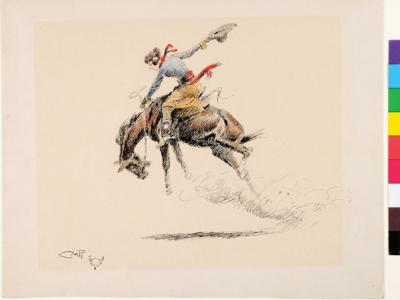
Fannie Sperry was born on a homestead in the Prickly Pear Valley in 1887. Her mother taught her to ride almost before she could walk. At a time when women still rode sidesaddle, Fannie cast aside Victorian decorum and rode astride in a divided skirt. On weekends, she and her brother Walter would round up wild horses that roamed the hills and drive them into the corral where Fannie rode the wildest ones.
At the Montana State Fair in Lewis and Clark County in 1904, Fannie made her first professional ride, not on a bucking bronco, but as a relay racer. The Montana relay featured women riders who changed horses and saddles at top speed. Fannie and the “Montana Girls” rode relays across the Midwest in 1905, scandalizing crowds in their daring black bloomers. In 1907, Fannie began to ride in women’s bucking horse competitions.
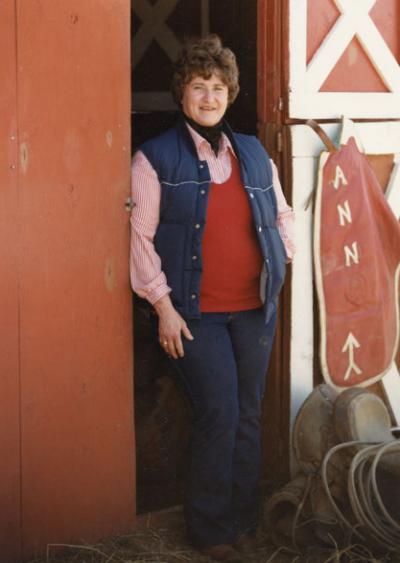
After a cowboy died at the Calgary Stampede in 1912, Fannie rode his killer horse, Red Wing. That ride went down in rodeo history earning her the title, “Lady Bucking Horse Champion of the World.” She married rodeo clown Bill Steele in 1913 and earned the title again. Unlike most other bronc-busting contemporaries, Fannie rode “slick” instead of hobbled, a concession allowed women contestants. Most women rode hobbled, their stirrups tied together beneath the horse’s belly for greater stability in the saddle. But hobbling was dangerous as it prevented the rider from kicking free. Slick riding demanded precision, balance, courage, and unusual strength. Fannie was the only woman rider among her contemporaries to ride her entire career slick, just like her male counterparts.
Any ride could end badly as Havre legend Marie Gibson’s tragic death illustrates. Born in 1894 and married at sixteen, Marie was divorced with children to support when she began trick riding for prize money. Her professional debut came in 1917 at Havre’s Great Stampede. After a second marriage to rodeo veteran Tom Gibson in 1919, Marie’s husband retired and she went on to travel widely, busting broncs overseas and back East. Her many titles included World Champion Cowgirl Bronc Rider in 1924 and 1927.
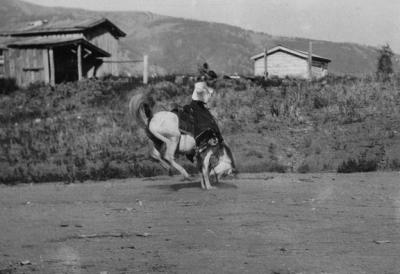
Marie had just made a successful ride on a wild bronc in Idaho in 1933. The horse was still bucking as the pickup man approached to take her off. In a freak accident, the two horses collided and Marie’s horse lost his balance and fell on her, fatally fracturing her skull. Her hobbled stirrups prevented her from kicking free.
After World War I as rodeo became its own genre, Fannie Sperry Steele and Marie Gibson were among the first generation of professional Montana cowgirls. They witnessed the transition as rodeo matured into a profession and communities began to establish their own rodeo events.
As the first national professional rodeo organization formed in 1929 with men and women as members, Marge and Alice Greenough of Red Lodge bridged the transition. Their father, “Packsaddle Ben” Greenough, was a local character and seasoned guide who kept horses by the hundreds. A rock-littered corral at the Greenoughs’ base camp served as his children’s playground. Ben expected his children to gentle the wildest horses. So they learned their craft out of necessity. “Nobody,” Marge reflected, “could get bucked off in those rocks and live.”

Alice rode her first bronc in public at the Forsyth Rodeo in 1919 at seventeen. Marge, five years younger, won a $15 purse for the half-mile cowgirl race at the Red Lodge rodeo in 1924. Marge jockeyed and later rode bareback broncs and steers while Alice did exceptional trick riding. Both sisters eventually rode bucking broncos and bulls, winning championships across the United States.
The Greenough sisters were refined, well-spoken, and dressed like ladies when they were not riding. They endured the same struggles as their male counterparts, suffered the same injuries,
and rode the same stock. The Greenough sisters, their saddle-bronc champion brother Turk, and other family members helped bring the professional Home of Champions Rodeo to Red Lodge. Credit goes to Alice Greenough for forming her own rodeo company to facilitate the first women’s barrel racing competition.
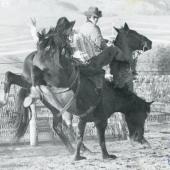

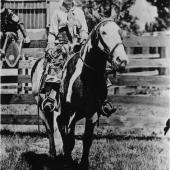


These four spirited, independent women are all members of the National Cowboy Hall of Fame. Among the 266 members, 33 are women and only 12 rode broncs. Fannie Sperry Steele honored in 1975, Alice and Marge Greenough in 1983, and Marie Gibson posthumously in 2006, are quintessential Montana women who take their places among the best of the best.
Marie Gibson’s fatal wreck came on the heels of another horrific accident, the death of bronc rider Bonnie McCarroll at Pendleton, Oregon, in 1929. Promoters began to curtail women’s participation in rough stock competition. World War II saw further limitations as cowboys were in short supply and cowgirls were even fewer. Madison Square Garden hosted its last women’s bronc riding contest in 1941. Women’s competitions became far less athletic and focused on barrel racing and pageantry.
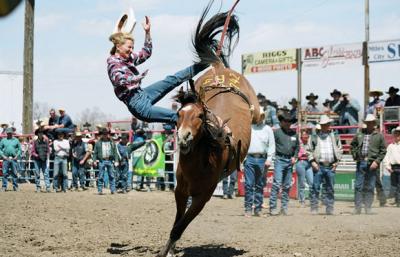
Ann Secrest Hanson of Jordan, Montana, was an experienced barrel racer but found the sport unsatisfying. As she and her first husband hosted training schools for rough stock riders, Ann became highly skilled at “pickup” — plucking cowboys off their bucking broncs and bulls or off the ground — and herding angry bucking stock out of the arena. Pickup riders perform an essential and dangerous job but are rarely in the limelight.
In 1962 when officials at the famous Miles City Bucking Horse Sale were short a pickup rider, Ann filled in. That began a 30-year career as pickup at professional, amateur, college and youth rodeos; rodeo schools; and other events. She was one of very few female “pickup men.” Discrimination was tough. Ann worked for lesser pay than her fellow pickup men for the first two years. Yet even though she earned the respect of her male counterparts, the Professional Rodeo Cowboys Association steadfastly refused to allow female members.
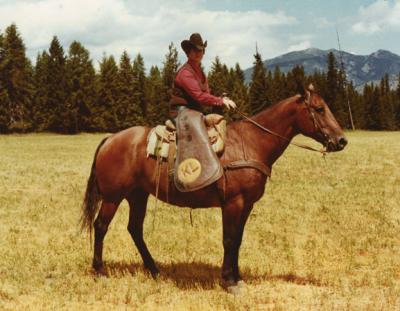
Despite the difficulties, Ann found her niche in this tough, hazardous work. Today she is a devoted horse breeder, musician, artist, award-winning poet, and 2003 inductee into the National Cowgirl Hall of Fame. Ann says that she got along by always doing her best, riding a good horse, and keeping her comments to herself.
When an injury ended runner Jonnie Jonckowski’s Olympic dream in 1976, she chose a new, albeit rocky, trail. Competitive bull riding fulfilled her adventurous spirit and daring pluck. In 1986 after 10 years’ hard work, Jonnie won her first of two bull riding championships. That first win at Guthrie, Oklahoma, on a huge brindle bull named B12, came the day after a bull fell on her and severely crushed her leg. Unable to walk, she was lifted onto B12. Jonnie cast aside excruciating pain and burst out of the chute, riding that day, as always, like a champion.
Jonnie’s persistent campaigning for women to compete in rough stock events broke many barriers including at Pendleton, where she was the first woman to ride that arena since Bonnie McCarroll in 1929. And at Cheyenne Frontier Days, Jonnie was the first woman to ride there since Alice Greenough in 1940.

Inducted into the National Cowgirl Hall of Fame in 1991,
Jonnie was hardly finished. Despite financial crises, injuries, and gender barriers, Jonnie’s fierce determination earned her a place in the 1992 and 1993 Men’s World Bull Riding Championship where she was the first woman to compete in that event. Her efforts helped open other opportunities in rough stock riding denied women since the 1930s.
Jonnie now relishes giving back to the Billings community. Her nonprofit Angel Horses, Inc., offers rescued horses and other animals hope and purpose, working with kids and kids at heart in a therapeutic environment.
Each of these Montana women made significant contributions. As author Teresa Jordan observed, “Through a combination of necessity, circumstance, and determination, they made a place for themselves in the larger world of horses, cows and men...”
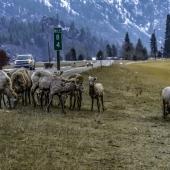
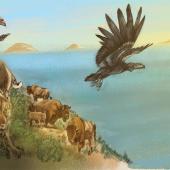
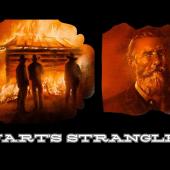

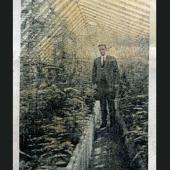
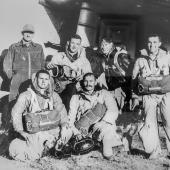
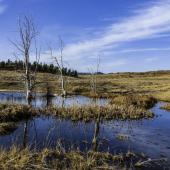

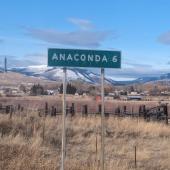
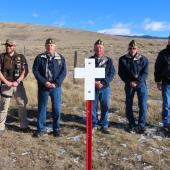
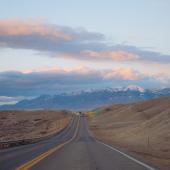
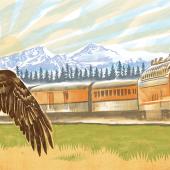
- Reply
Permalink